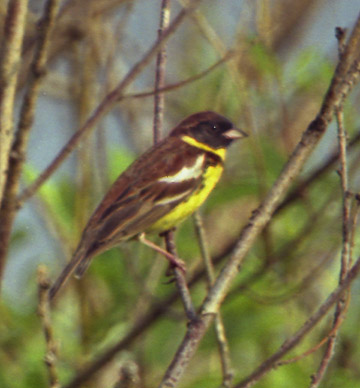(Reference updated) |
(References updated) |
||
| Line 25: | Line 25: | ||
Annual in [[Norway]], [[Sweden]] and in [[Britain]] (c.218) where the vast majority occur in September with most on [[Shetland]], fewer on the east and south coasts. Numbers have greatly increased in recent years and more are being recorded away from the Northern Isles but [[Fair Isle]], Shetland remains the prime locality. Vagrants also recorded in [[Spain]] and [[Portugal]], [[Latvia]], [[Denmark]], the [[Netherlands]] and [[Belgium]] and in October 1991 in Sinai, [[Egypt]]. | Annual in [[Norway]], [[Sweden]] and in [[Britain]] (c.218) where the vast majority occur in September with most on [[Shetland]], fewer on the east and south coasts. Numbers have greatly increased in recent years and more are being recorded away from the Northern Isles but [[Fair Isle]], Shetland remains the prime locality. Vagrants also recorded in [[Spain]] and [[Portugal]], [[Latvia]], [[Denmark]], the [[Netherlands]] and [[Belgium]] and in October 1991 in Sinai, [[Egypt]]. | ||
==Taxonomy== | ==Taxonomy== | ||
| − | ====Subspecies<sup>[[#References|[1]]]</sup> | + | ====Subspecies==== |
| + | There are 2 subspecies<sup>[[#References|[1]]]</sup>: | ||
*''E. a. aureola'': | *''E. a. aureola'': | ||
:*Boreal forests of [[Finland]] to Bering Sea; winters to [[Indochina]] | :*Boreal forests of [[Finland]] to Bering Sea; winters to [[Indochina]] | ||
| Line 41: | Line 42: | ||
''[[Media:Emberiza aureola (song).mp3|Listen in an external program]]'' | ''[[Media:Emberiza aureola (song).mp3|Listen in an external program]]'' | ||
==References== | ==References== | ||
| − | #{{Ref- | + | #{{Ref-Clements6thAug13}}#Bird Guides |
#Wikipedia | #Wikipedia | ||
#Collins Bird Guide ISBN 0 00 219728 6 | #Collins Bird Guide ISBN 0 00 219728 6 | ||
Revision as of 18:09, 5 September 2013
- Emberiza aureola
Identification
14-15.5 cm
Breeding Male
- Dark rufous-brown upperparts and breast band
- Black face
- Bright yellow underparts
- Large white wing patch on lesser and median coverts
- Pink lower mandible
Female
- Paler yellow underparts
- Buffy supercillium
- Greyish-brown upperparts, heavily streaked
- Dark rear eyestripe
- Grey-brown median crown stripe
- White wing bars
- Pink lower mandible
Distribution
Breeds in central and south-eastern Finland, although becoming very rare in recent years, and across Russia from about 53N to the southern Kola Peninsula and White Sea. Outside the Western Palearctic breeds widely across Asia to Kamchatka and northern Japan.
Autumn migration begins in late-July and August with most birds wintering from eastern Nepal to southern China and Indochina. Spring passage begins in early-April and arrives on Western Palearctic breeding grounds in early June.
Annual in Norway, Sweden and in Britain (c.218) where the vast majority occur in September with most on Shetland, fewer on the east and south coasts. Numbers have greatly increased in recent years and more are being recorded away from the Northern Isles but Fair Isle, Shetland remains the prime locality. Vagrants also recorded in Spain and Portugal, Latvia, Denmark, the Netherlands and Belgium and in October 1991 in Sinai, Egypt.
Taxonomy
Subspecies
There are 2 subspecies[1]:
- E. a. aureola:
- E. a. ornata:
- Amur River to Manchuria, North Korea, Kamchatka and Kuril Issland
Habitat
Open areas, usually close to water with dense shrubs and willow and birch scrub, also forest edges and peat bogs. On passage occurs in cultivated areas, scrubland, sometimes reedbeds.
Behaviour
Breeding
A ground-nester, laying 4-6 eggs
Diet
The diet mainly consists of seeds, but includes insects when rearing a brood.
Vocalisaton
<flashmp3>Emberiza aureola (song).mp3</flashmp3>
Listen in an external program
References
- Clements, J. F., T. S. Schulenberg, M. J. Iliff, B.L. Sullivan, C. L. Wood, and D. Roberson. 2013. The eBird/Clements checklist of birds of the world: Version 6.8., with updates to August 2013. Downloaded from http://www.birds.cornell.edu/clementschecklist/download/
- Bird Guides
- Wikipedia
- Collins Bird Guide ISBN 0 00 219728 6
Recommended Citation
- BirdForum Opus contributors. (2024) Yellow-breasted Bunting. In: BirdForum, the forum for wild birds and birding. Retrieved 3 May 2024 from https://www.birdforum.net/opus/Yellow-breasted_Bunting





